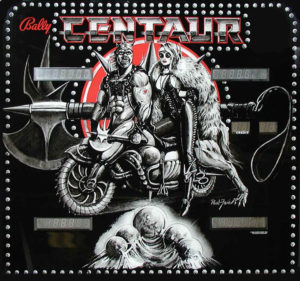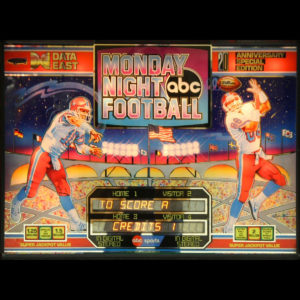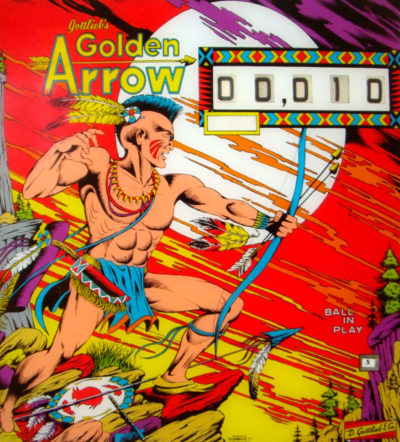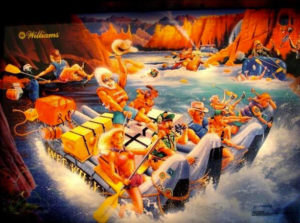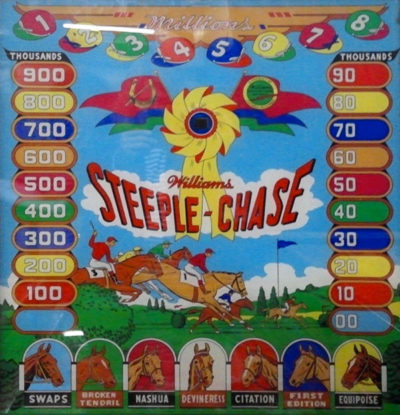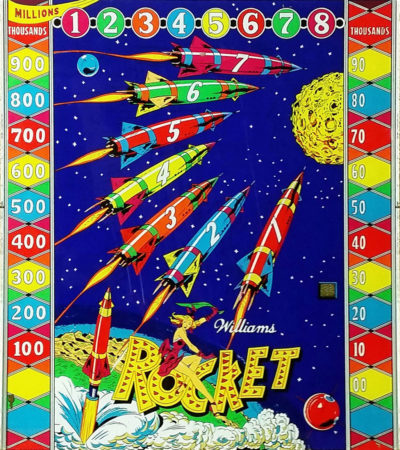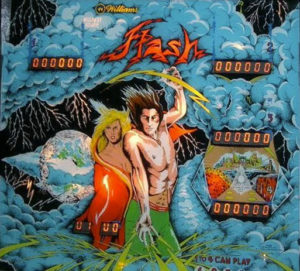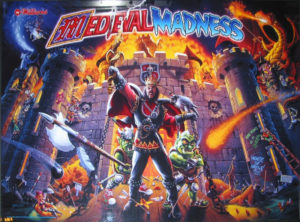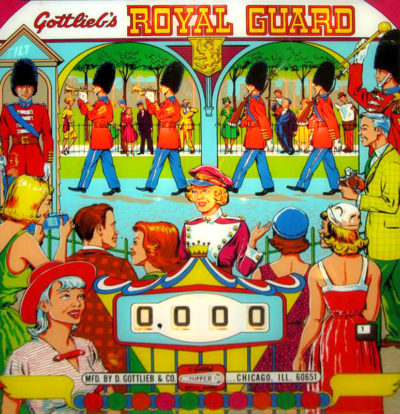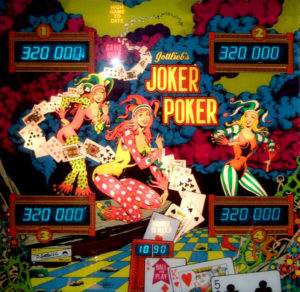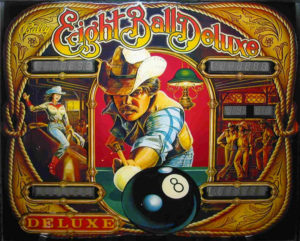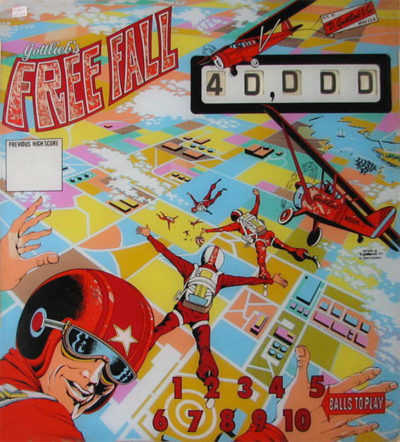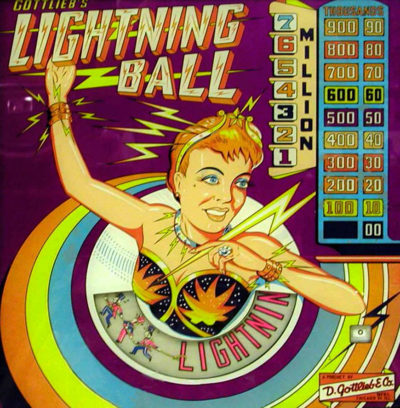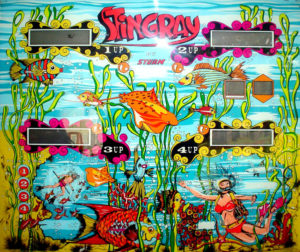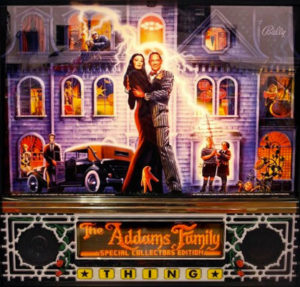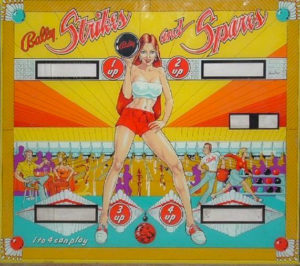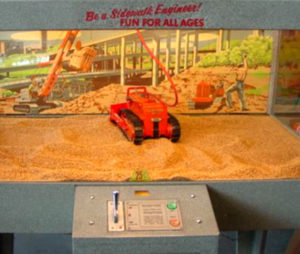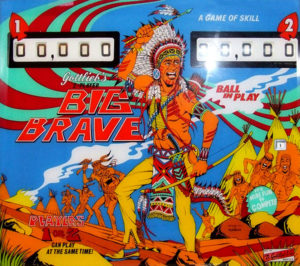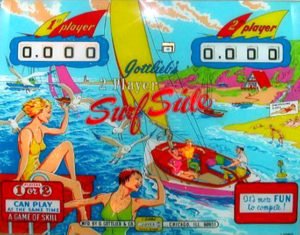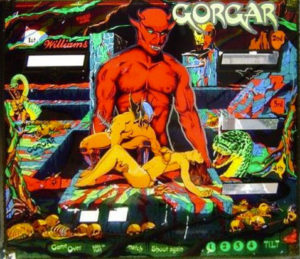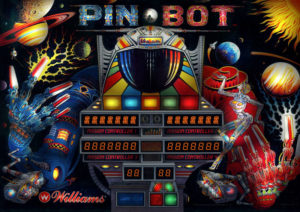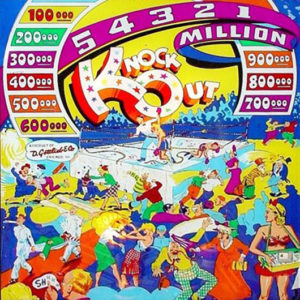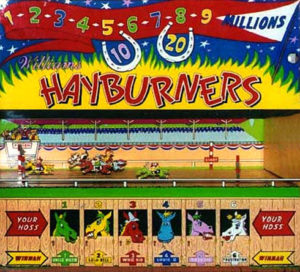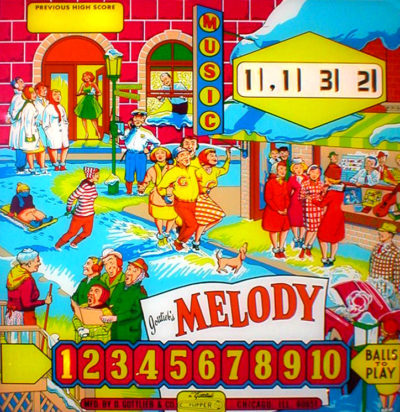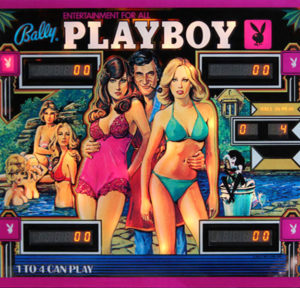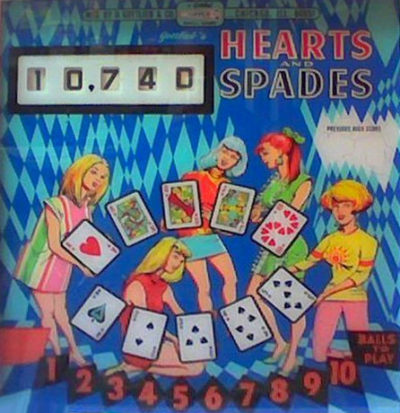-
Mata Hari was released in April of the year and designed by Jim Patla with artwork accolades going to Dave Christiansen. 16,200 of these machines were produced in the new solid-state format (as seen in the museum) as well as bunch of electromechanical machines (170, to be exact) to keep the non-computer savvy operators happy and buying machines they knew how to fix. This machine before you is one of the finest examples of this ultra-rare mechanical format. Like the solid-state version, the center kickout hole scores 3,000 points and each successful shot in the hole advances the bonus multiplier. The A and B skill shots advance the horizontal sequence of increasing values in the center of the playfield. 50,000 points are awarded when a battery of drop targets is hit. If both batteries are knocked down, the drop targets reset and hitting all again awards the replay. Score is another replay option.This beautiful piece of art was designed by Jim Patla with artwork by Paul Faris. 3,700 units were designed and a reprise run of 1,550 games were made in 1983 due to its popularity. The first thing one notices when walking up to this game is the color theme and the vibrant lighting. Pressing either flipper button when the game is in attract mode gives you an instructional light show on its features; the orb feature is the most exciting. Spelling out orbs by completing the drop target sequence stores another potential ball into play if the release orbs target is hit. This target has a magnet under it which holds the ball in position when the orbs are ejected. The balls are ejected from under the playfield through a baseball machine pitcher-like mechanism mounted upside down in the shooter lane. This mechanism was inspired by a Bally ‘50s game called Balls A Poppin. The captive ball drop target sequence is another tough goal to accomplish.This Gottlieb game is one of the five in the museum of the “flipper” series from Gottlieb. These games are all add-a-ball games. The layout of this game parallels a future Gottlieb classic by the name of “Buckaroo” (also in the museum). 1,550 of these machines were manufactured. Wayne Neyens designed the game and Roy Parker established the art package. Fifteen targets on the roto-target are present and spinning the roto would bring up new numbers to complete. If you are skillful enough to sequence four numbers in a row, an extra ball is awarded. The bull’s-eye target awards an extra ball also. Each time an extra ball is awarded, the backglass animation activates. The cowboy shoots at the targets, which causes them to spin. No match feature here and tilting the game forfeits the ball in play as well as a future ball in play.Here’s another example of a Gottlieb single-player mechanical game when all the other manufacturers during this period were developing solid-state computerized machines. Ed Krynski is the designer with Gordon Morison the artist of choice for this model, one of 1,530 machines made. The machine itself is a classic ’70s. Ten numbers is your goal here. You achieve these ten targets by hitting and rolling over the appropriate spots on the playfield. Hitting the spinner spots the numbered target the spinner stops on. If you’re lucky to complete the targets, the special lights up and advances through the ten numbers. Hitting the lighted number with “special” lit means more free time playing the game. Score for replays is your second goal. Nice artwork in a single player game, one of the last produced.White Water is a 1993 pinball game designed by Dennis Nordman and released by Williams. The theme is based on White water rafting, which is reflected in the game’s ‘wild’ ramps and very fast gameplay. Overview White Water is a non-licensed pinball machine with a primary objective of moving your raft down the river to “Wet Willy’s” in order to get the “Vacation Jackpot.” You move your raft down the river by shooting the flashing “Hazard” shots, each with a unique rafting theme name. Each time you complete a raft, the number of “Hazard” shots you must hit successfully to complete the next raft increases. It takes eight completed rafts to advance to “Wet Willy’s.” Successfully completing “Wet Willy’s” enables the player to attempt the collection of the “Vacation Jackpot.” There are subsequent objectives in the game, which include: Multiball: To start multiball, light the lock ball shot by hitting the “Lite” and “Lock” targets and then successfully shooting the ball in the ball lock, also called the “No Way Out” Hazard; doing this 3 times will start multiball. Whirlpool: Completing the “Whirlpool” shot will activate one of six awards or modes, which is determined by what is lit when the “Whirlpool” shot is hit. To light the “Whirlpool”, thus making the shot active, successfully hit the “Insanity Falls” shot. After hitting the “Insanity Falls” shot, you will know the “Whirlpool” is active when the red light above the shot is lit. One of the six awards or modes starts when the Whirlpool shot, also called “Bigfoot Bluff”, is successfully competed. Big Foot Hotfoot: There are two “Hotfoot” targets in the middle of the playfield. Hitting both targets comprises a complete “Hotfoot”, and the “Hotfoot” targets are reset. Depending on the machine settings, successfully completing the specified number of “Hotfoot” targets starts the “Bigfoot Hotfoot” mode which allows the player to get successive “Bigfoot Jackpots.” Lost Mine: Hitting the ball in the “Lost Mine” shot awards an item needed to start the “Gold Rush” multiball. There are three items that must be collected to start this multiball, a flashlight, a map, and a key; and these items can be collected through either the “Lost Mine” or the “Bigfoot Hotfoot.” Once all three items have been collected, successfully hitting the “Lost Mine” shot starts the “Gold Rush” multiball.This unique woodrail game was screwed together in November of the year following the success of a Gottlieb space theme called Rocketship. Harry Williams designed the playfield and game rules while George Molentin inked the artwork. The object of the game is to score at least three rockets on the backglass in order. Doing so awards a replay. This is not an easy task as most of the rockets are “selected” at the top of the machine’s playfield and, even though you may have had a countdown going on a desired numbered rocket to complete this feat, the next ball will most likely change the selected rocket in your countdown sequence! To spot a rocket, you must count down five levels to light the fire bumpers. Hitting one of these spots your actively selected rocket. More replays are yours if you can achieve four, five, six, or seven rockets in order, an extremely rare feat. Score is also another way to score replays. A very challenging playfield for sure, between trying to change your selected rocket and the high-side drain exits take some time to master.This game was a breakthru game for Williams in January. It was designed by Steve Ritchie with art by Constantino Mitchell. Flash was the first game to have a continous background sound during play and the crescendo of the sound sped up as you advanced thru the game. This is also the first game to use “flash lamps”, which are higher voltage lights that really make a presence when they light. The first thing you notice on this non-speaking game is, when you shoot the ball from the plunger, the ball travels diagonally across the playfield and ends at the top of the playfield from left to right. The top rollovers consist of 4 numbers. If you hit 1-3, you get a double bonus; all four made gives a triple bonus. 19,505 games were made, a big production run. This game also has the advance bonus eject hole, drop targets, and, of course, the bright “flash” show when activated. This game was a main staple in arcades of the ’80s.Flippers (2), Pop bumpers (3), Ramps (2), Autoplunger. A left-side catapult propels ball airborne into a habitrail. Two pop-up trolls in playfield become active during “Trolls!” mode. Tina Fey (of “Saturday Night Live” fame) did the voices of the “Opera Singer” princess and the Cockney-talking princess, and Andrea Farrell did the voices of the Jewish princess and the sexy princess. Greg Freres was the voice of the jousting announcer and one of the trolls while Francois Du Grim was voiced by Vince Pontarelli who also did the other troll. Look no further! This game, in my humble opinion, takes the prize as the most sought-after, inventive game of the ‘90s! Brian Eddy designed this machine with 4,016 units screwed together. The action, endless vocal calls, the exploding castle, the pop-up trolls and the moat and dropping gate make this machine one of a kind. The value of this machine is going through the roof, more than doubling its original price. The six kings from six different castles must be defeated by attacking the castle walls. Defeating a king makes the fort collapse. It’s nearly impossible to complete this feat. The princess must be rescued up the upper right ramp when activated (the princess’s vocals are none other than Tina Fey’s voice). Many multiball challenges await. The trolls must be hit many times to be conquered. The whole package is artistically and musically amazing. Most of these machines are tucked away in home arcades at this point. Enjoy!Gottlieb Joker Poker pinball. An interesting design, and only made in a 4 player version (no 2 player, unusual for Gottlieb pinball). One bank of five ace drop targets, one bank of four king drop targets, one bank of three jack targets, one bank of two queen drop targets, and a single ten drop target. Pretty cool pinball design really. Two pop bumpers, one slingshot, two 3″ flippers. They made 820 Gottlieb EM Joker Poker pinballs.This game was very successful for the Bally company. It was initially released in 1981 as a full upright pinball with a production of 8,250 games. This version of the game in its third release had a run of 8,850 games. This cabinet was a unique design for Bally, as was used in a few other games like Pac-Man pinball. Designed by George Christian with art by Margaret Hudson, the pool-themed game is a classic. The basic object here is to hit all seven drop targets representing pool balls. The eight-ball drop target then pops up. Upon hitting it, “deluxe” lights up behind where the drop targets were. Making “deluxe” increases your bonus upon completion of the ball and advances the deluxe hold-over feature on the backglass. Hitting the in-line drop targets awards points and specials. The same is true if you shoot the left ramp to the top.Wayne Neyens and Roy Parker again teamed up to create this pretty late-‘50s pin with an animated backglass. 950 units were made. The playfield has two gobble holes, which award 100,000 points for each rollover completed. If all six rollovers are made, a replay is awarded and the gobble holes are special holes. The main feature of the game is advancing the lightning ball backglass spelling. Each time you make the three colors on the playfield via rebound rubber or rollovers, the unit advances one step. If you are skillful enough to complete the lightning ball spellout, a replay is awarded, and each time you make the three colors to advance the letter, another replay is added. It’s not an easy task to complete. There’s always beating the game by scoring or matching. This game was somewhat retro as it has backglass light scoring, since Gottlieb already used reel scoring.Here’s a 1977 Stern ‘Pinball’. This was Stern’s first solid state machine and marked the beginning of a long and interesting history for the company. Designed by Mike Kubin, it’s a fast game that has some wicked out-lanes and very quick ball times. There are no mini-posts above the out-lane guides which make controlling the ball near the out-lanes very difficult. Stingray, the game made by Stern following ‘Pinball’ also lacked these posts, but games made thereafter had the posts which dramatically improve the player’s ability to control the ball and avoid the out-lane. This game has a basic rule-set. Knock down the 5 drop targets twice in one ball to score the special. The saucer on the right side of the playfield awards a somewhat random award and the spinner shot on the left is a very satisfying shot to hit.This “special edition” game was produced to recognize the fact that this game, when initially released two years earlier, was the biggest number production game ever made in the contemporary era, with a total production run of 20,270. This game was produced in 1,000 examples. Pat Lawlor designed the machine with John Youssi getting accolades for the artwork. Gadgets abound in this machine, which is augmented by the gold detailing over the standard unit. The main theme here is to complete all 12 parts of the house panel. Doing so brings you to the ultimate level of excitement. Multi-ball options abound as well as “Thing”, consisting of just a hand, grabbing the ball in the upper-right corner of the machine. A magnet under the play field provides strange ball play as well as Thing “flipping” the ball remotely if hit. The sounds and art are fantastic representations from the movie of the same name. This game is #3!This Williams machine fabricated in 1955 is a strange game that really is more of a toy. A player gets to operate a remote-controlled bulldozer around a big sandbox for 120 seconds using two remote controllers in synthetic gravel. It appears the idea for this machine was to cater to the under-12 market as no rewards, extra time, or extra plays were programmed into the electromechanical boards within the machine. No scoring and no prizes! This machine was often confused with Williams’ Crane (1956) because it has a sign on top of the game that says, “Be a sidewalk engineer.” Ten cents allowed adults a two-minute break to get a quick snack while a child was entertained. I don’t think this would be the case in today’s thinking…Big Brave is a two-player electromechanical machine. 3,450 units were produced. Ed Krynski designed the machine and Gordon Morison was in charge of the artwork. This game was a typical Gottlieb game of the era. It has drop targets, resetting targets, bonus feature, double bonus option, and a special. Making the B I G rollover lights the pop bumpers. Hitting all five drop targets awards 5,000 points. Hitting the last drop target left when the B I G is hit awards a special. The vari-target, as it was called, was an exclusive Gottlieb design. As you hit the target – depending how hard you hit it – would result in bigger point values. It will then reset to be hit again and again. A four-player version of this game, Big Indian, was also produced.This is the next-to-last machine Williams made under the Bally moniker and the first game made to “reinvent” pinball in a last-ditch effort to save Williams from ceasing pinball manufacturing. 6,878 machines were made. George Gomez designed the new platform with Greg Freres and John Youssi designing the art package. This is Star Wars; the last games from Williams were the most technologically advanced games pinball has ever known. The incorporation of a reflecting video monitor with interactive playfield video feedback is revolutionary. The top of the playfield is mostly hidden from view except for a few selectively placed spots which light on occasion. This machine consists of nine different modes which must be conquered to proceed to the ultimate mode, that being the destruction of Mars. A very different game that sold well. However, Williams pulled the plug on pinball and thereafter focused on slot machines.This pinball had a run of 1750 units. Designed by Ed Krynski with artwork by Art Stenholm, this 2 player four flipper game has no specials. The object of the game is to score a lot of points by advancing the yellow and red multipliers up to 100x where up to 500 points could be hit. Hitting the 100x level resets the hit column back to 1x. Extra balls are awarded if the roto spin target is hit when the star is in position. The use of the four flippers in the game makes one feels that the machine has two playfields in one. The new design pop bumpers, and auto ball lift are in early use here as well as the ball count meter. A challenging game that’s hard to beat!!!This game was a breakthru game. It is the first-ever talking pinball machine. Games of this era had synthesized sound, but this game spoke. The speech wasn’t very clear or very wordy, as memory chips of this era couldn’t hold too much information compared to today’s games, but it was a sensation for Williams. The production run for the game was 14,000 units. It was designed by Barry Oursler with art by Constantino Mitchell. The top three rollover lanes would, if completed give up two, then three times bonus. The snake pit in the upper-left playfield has a magnet under it, which captures the ball for bonuses and Gorgar’s chance to use his seven-word vocabulary. Spelling out the word “Gorgar” makes the monster say his name and increases bonus values. This game also incorporates the background noise made famous in the Williams game Flash (in the museum). This time the background sound is of a heartbeat. It gets faster and faster as you advance.This machine was a big hit for Williams with 12,000 machines created. A skill shot starts your adventure with different point values. A three-bank drop target or single right target advances the planets lit in the playfield. If you advance to the lit planet, a free game is your reward. The light grid, if hit when a solo target is lit, opens the visor. Otherwise, hitting all the lights opens the visor. Locking two balls in the “eyes” of the robot starts two-ball multiball. Lock one ball in one eye and shoot for the left solar ramp. Advance the bonus value by making the left ramp loop when the visor is down. This game is fun, challenging and the vocals egg you on throughout your adventure.This game was produced in December of the year and designed by Harry Mabs with artwork by Roy Parker. 3,000 of these machines were made. The unique feature built into this machine is the animation unit in the top center of the play field. Two mechanical men are represented as boxers in a boxing match. Lights illuminate the bout when a knockout is scored by rolling over a “KO” rollover, a “KO” target, or completing bumpers 1 to 5. This game is one of the first examples of pinball animation. Another feature of the game is the pop-up bar at the bottom of the play field, preventing you from losing your ball in play for an extended period. Since the gap between the flippers is so massive, this addendum to the play field was installed to prolong the play period of the ball. A special feature is included in the game as well as a replay if 15 knockdowns are scored in one game and a replay for every knockdown scored thereafter.This rare add-a-ball game was released in April. It was designed by John Osbourne with artwork by Gordon Morison. A minimal total of 270 units were soldered together at the time. This is a small number for a pinball run. The replay version had a much larger production and the name of that game was Hit The Deck. As you can see from the backglass, Gottlieb tried to experiment with a score reel that was completely different in coloring. This was to attract attention to the game and attract quarters. The object of the game is to roll over the red number and/or black number sequence inherent in the game. If you are skillful enough to get the 9 to Ace sequence, some wow options will light up to score extra balls. A kickback feature is incorporated into the game in the upper-left area. This single-player game is challenging and a rare sight to see.Demolition Man is a Williams pinball machine released in February 1994. It is based on the motion picture of the same name. It is part of WMS’ SuperPin line of widebody games. Sylvester Stallone (John Spartan) and Wesley Snipes (Simon Phoenix) provided custom speech for this game during ADR sessions at Warner Brothers Studios in Los Angeles under the direction of Jon Hey. Hey scored the music of the pinball game in part based upon the movie score by Academy Award winner Elliot Goldenthal, but including new music. Multiball modes This game is centered on multiball modes. The player has to shoot the left ramp when the “freeze” light is lit (lit by the right inlane) to “lock” a ball. When the required amount of locks are made, the player has to shoot the left loop to start multiball. Fortress Multiball (2 balls required) – A normal multiball mode with 3 jackpots and the “Super Jackpot”. 1-4 balls can be shot up. Museum Multiball (3 balls required) – Jackpots everywhere, except the standups. After the “Super Jackpot” the Multiball starts over. 3-6 balls can be shot up. Wasteland Multiball (4 balls required) – Same as “Fortress Multiball”. If not getting the lighting jackpots, the next jackpot will appear and the previous jackpot will stay. 4-8 balls can be shot up. Cryoprison Multiball (5 balls required) – The “Super Jackpot” is lit, from the beginning of the multiball. After getting the “Super Jackpot” it will lit again after hitting an arrow or more. Completing all four multiball modes lights the right ramp for the wizard award, Demolition Jackpot, which is the total amount of all the jackpots collected during the game. The Demolition Jackpot is lost if the ball drains. If you hit all jackpots in a multiball, the “Super Jackpot” light will lit. Getting the ball up to the “Cryo-Claw” whilst, you will get it. The “Super Jackpot” light turns off, if all the balls drain and the Multiball is over, the “Super Jackpot” is lost.Pro Pool originated in December with 800 units being fabricated. This add-a-ball machine was designed by Ed Krynski with artwork by Gordon Morison. Two replay versions of the game were also made: a two-player version called Big Shot and a four-player version called Hot Shot. Obviously the theme of this game is the game of pool. The playfield is symmetrical and the way to win extra balls is by completing the left and/or right drop target battery. Doing so will lift the left and/or right wow rollovers for this award. The drop targets reset once the sequences are completed. Of course, an operator-adjusted score is another way to score a couple of balls. Back in the ‘70s, multiple balls or replays could be achieved on the game. Today, one free game on a current solid-state game is the common win. Operators have made it harder to achieve free games today as free games yield no income and only result in down time for the machine to earn coins in the till.This game is the pinball rendition of the HBO TV show, The Sopranos, complete with voices of most of the actors in the series. It was designed by George Gomez with the art package created by Kevin O’Conner. The main object of the machine is to advance through the ranks of the mob by advancing your status through playfield rollovers and cracking the safe. Doing so is difficult to achieve to top capo. A multiball feature is also incorporated into the game behind a solo drop target. Video modes must be achieved to complete the placard of events culminating in the completion of your missions. So many pop bumper hits light up the party at the bing in the upper right, which scores a bunch of points. Mastering this machine is tough, but that’s what brings you back to try again.October was the birthdate for this machine. It was designed by Ed Krynski with artwork by Art Stenholm. Low production run of 550 units. This is an add-a-ball game, the replay version being called Sing Along. This game was a variation on a classic Gottlieb game Kings and Queens, in that it contains the four side-by-side kickout holes made popular in 1965. Here, the object of the game is to complete four same-colored numbers vertically in a row to randomly cause the kickout hole to light to score an extra ball if you land in the hole when it’s lit. If you didn’t win a ball, each light in the column would award 10 points. If you have most of the lights lit, a run at the kickout holes awards a lot of points in a hurry which, in this game, also awards extra balls. One center target is also incorporated into the game, awarding 100 points when hit and lights the pop bumpers for higher scoring.This solid-state game was very popular when it was released and has a lot of smooth shots to complete. It was designed by Jim Patla with artwork by Paul Faris. Production run was 18,250 units. This pre-speaking pinball has Hugh Hefner on its backglass with Bunny Sondra Theodore posing. At the top of the game are four rollover lanes, which advance when hit to a special and advance the bonuses and grotto award. Hitting the five Bunny targets also advance a feature to win extra balls and specials. A unique kickback lane advances with every entrance into it. A five-pack of drop targets also advance certain features on the game. If 20,000 points are made on the bonus system, this point count is carried over to all remaining balls and then some. The nicest shot on the game is going up the right side from the flipper and looping the ball into the grotto. The sound originates from the old TV show “Playboy After Dark.”
-
Mata Hari was released in April of the year and designed by Jim Patla with artwork accolades going to Dave Christiansen. 16,200 of these machines were produced in the new solid-state format (as seen in the museum) as well as bunch of electromechanical machines (170, to be exact) to keep the non-computer savvy operators happy and buying machines they knew how to fix. This machine before you is one of the finest examples of this ultra-rare mechanical format. Like the solid-state version, the center kickout hole scores 3,000 points and each successful shot in the hole advances the bonus multiplier. The A and B skill shots advance the horizontal sequence of increasing values in the center of the playfield. 50,000 points are awarded when a battery of drop targets is hit. If both batteries are knocked down, the drop targets reset and hitting all again awards the replay. Score is another replay option.




